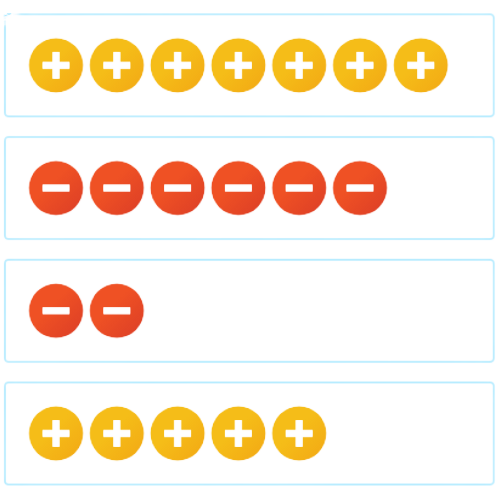Add and subtract integers using counters
Key Notes:
| 🔢 What Are Integers? |
- Integers are positive and negative whole numbers, including zero.
Examples: -5, -1, 0, 3, 7
| 🔴🔵 What Are Counters? |
Counters are visual tools to help understand positive and negative integers.We use:
- 🔵 Blue counters to represent positive numbers (+1)
- 🔴 Red counters to represent negative numbers (–1)
| ➕ Adding Integers Using Counters |
| Same Signs – Add and Keep the Sign |
Add the number of counters and keep the same sign.
Example:
- (+3) + (+2)
- 🔵🔵🔵 + 🔵🔵 = 🔵🔵🔵🔵🔵 → +5
Example:
- (–4) + (–2)
- 🔴🔴🔴🔴 + 🔴🔴 = 🔴🔴🔴🔴🔴🔴 → –6
| Different Signs – Subtract and Use the Sign of the Bigger Number |
Example:
- (+5) + (–3)
- 🔵🔵🔵🔵🔵 + 🔴🔴🔴
- → Pair and cancel: 🔵🔴 🔵🔴 🔵🔴
- Remaining: 🔵🔵 → +2
Example:
- (–6) + (+2)
- 🔴🔴🔴🔴🔴🔴 + 🔵🔵
- → Pair and cancel: 🔴🔵 🔴🔵
- Remaining: 🔴🔴🔴🔴 → –4
| ➖ Subtracting Integers Using Counters |
Rule: Change Subtraction to Addition
a – b = a + (–b)
| Examples: |
Example 1:
- (+4) – (+2) → Change to: (+4) + (–2)
- 🔵🔵🔵🔵 + 🔴🔴 → Cancel pairs: 🔵🔴 🔵🔴
- Remaining: 🔵🔵 → +2
Example 2:
- (–5) – (–3) → Change to: (–5) + (+3)
- 🔴🔴🔴🔴🔴 + 🔵🔵🔵 → Cancel pairs: 🔴🔵 🔴🔵 🔴🔵
- Remaining: 🔴🔴 → –2
| 📝 Practice: |
| 🔹 Part A: Represent with Counters |
Draw 🔵 and 🔴 counters to represent the problems and solve.
- (+4) + (–3) = ______
- (–5) + (–2) = ______
- (+6) + (+2) = ______
- (–3) + (+5) = ______
- (+3) – (+1) = ______
- (–6) – (–4) = ______
- (+5) – (–2) = ______
- (–7) + (+3) = ______
- (–4) – (+2) = ______
- (+2) – (–5) = ______
✅ Answer Key
Part A:
- +1
- –7
- +8
- +2
- +2
- –2
- +7
- –4
- –6
- +7
🔹 Part B: Word Problems
Use counters (draw if needed) to solve:
- You gained 6 points in a game and then lost 4 points. What is your score now?
- A submarine is at –10 meters. It rises 6 meters. Where is it now?
- You owe 5 rupees and borrow 3 more. What is your total debt?
✅ Answer Key
Part B:
- +2
- –4 meters
- –8 rupees
💡 Tips:
- Practice with real or drawn counters!negative side.
- Cancel out 1 🔵 and 1 🔴 when together (they make 0).
- Change subtraction to addition by adding the opposite.
Learn with an example
➡️ Use counters to add 2 + 3.
You start with:

You add:

Which picture shows the sum?

You are trying to calculate 2 + 3.
Start out with 2 positive counters, which represent 2:

Now add 3 positive counters:

Since the counters are all positive, just count them. There are 5 positive counters, so 2 + 3 = 5.
🔥Use counters to subtract 3 − (-1).
You start with:

You subtract :

Which picture shows the difference?

You are trying to calculate 3 − (-1).
Start out with 3 positive counters, which represent 3:

You would like to take away 1 negative counter. However, it’s not possible to take away 1 negative counter, because there aren’t any negative counters in the first group. You can fix this problem by adding 1 pair of positive and negative counters to the first group, so that you have the 1 negative counter that is needed:

Now take away 1 negative counter:

4 positive counters remain. So 3 − (-1) = 4.
🔥Use counters to subtract -1 − 2.
You start with:

You subtract:

Which picture shows the difference?

You are trying to calculate -1 − 2.
Start out with 1 negative counter, which represents
-1:

You would like to take away 2 positive counters. However, it’s not possible to take away 2 positive counters, because there aren’t any positive counters in the first group. You can fix this problem by adding 2 pairs of positive and negative counters to the first group, so that you have the 2 positive counters that are needed:

Now take away 2 positive counters:

Try some practice problems!

